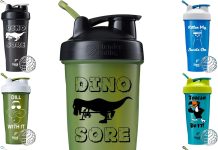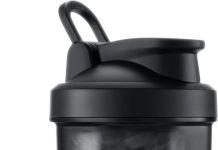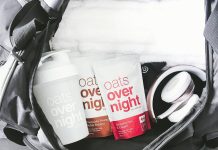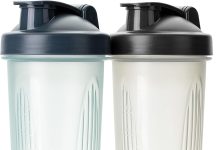Ladies and gentlemen, allow us to indulge you in the quest for the ultimate blending power in a Blender Bottle. As culinary enthusiasts, we are always on the lookout for ways to enhance our blending experiences and create the smoothest, most delicious concoctions imaginable. In this article, we will delve into the realm of blending tricks and discover the secrets that can elevate your blending game to new heights. Get ready to unlock the full potential of your Blender Bottle and revolutionize your blending endeavors!
Review contents
Choosing the Right Blender Bottle
Choosing the right Blender Bottle is essential for achieving the best blending results. There are several factors to consider when selecting the perfect Blender Bottle for your needs.
Consider the Size of the Blender Bottle
The first thing to consider is the size of the Blender Bottle. Think about how much you will be blending at once and how portable you need it to be. If you plan on making larger batches, a bigger Blender Bottle would be ideal. On the other hand, if you’re looking for something compact and easy to carry with you, a smaller size would be more suitable.
Look for a Blender Bottle with a Tight-Fitting Lid
It’s important to choose a Blender Bottle with a tight-fitting lid to prevent any leaks or spills while blending. A loose lid can result in a messy experience and can also affect the blending process. Look for a Blender Bottle with a lid that has a strong seal to ensure that you can blend with confidence.
Check for a Blender Ball or Mixing Grid
A Blender Ball or a mixing grid is a crucial feature to look for in a Blender Bottle. This small, metal ball or the grid is designed to help break down and mix the ingredients effectively. It creates a vortex when shaken, ensuring that all your ingredients are thoroughly blended. Make sure that the Blender Bottle you choose comes with a Blender Ball or a mixing grid.
Opt for a Blender Bottle with a Wide Opening
A Blender Bottle with a wide opening makes it easier to add ingredients and clean the bottle afterward. This feature allows you to pour in your ingredients without any spills or messes. Additionally, a wide opening facilitates thorough cleaning, ensuring that there are no residues left behind that can affect the taste of your next blend.
Preparing Ingredients for Blending
Before blending, it’s important to prepare your ingredients properly to ensure the best blending results. Here are some tips for preparing ingredients:
Cut Ingredients into Smaller Pieces
Cutting your ingredients into smaller pieces can make them easier to blend. Smaller pieces allow the blender blade to chop through them more effectively, resulting in a smoother blend. This is particularly important for larger or harder ingredients like fruits and vegetables.
Soak Ingredients in Liquid Before Blending
Soaking certain ingredients in liquid before blending can help soften them and make them easier to blend. For example, if you’re using dried fruits or nuts, soaking them in water or juice for a short period of time can help improve their texture and blending ability.
Defrost Frozen Ingredients
If you’re using frozen ingredients in your blend, make sure to defrost them beforehand. Blending frozen ingredients can put extra strain on the blender motor and may result in uneven blending. Allow your frozen ingredients to thaw slightly before adding them to the Blender Bottle.
Prevent Ingredients from Sticking
To prevent ingredients from sticking to the sides of the Blender Bottle during blending, you can lightly coat them in a small amount of cooking oil. This will help create a smooth blending process and ensure that all the ingredients are properly incorporated.
Pre-chill Ingredients for Better Results
For certain recipes, pre-chilling your ingredients can enhance the flavor and texture of the blend. This is particularly true for smoothies and shakes. Pre-chilling ingredients like fruits, yogurt, and milk before blending can result in a refreshing and creamy texture.
Blending Techniques
The way you blend your ingredients can greatly affect the overall result. Here are some key blending techniques to keep in mind:
Use Pulse Mode to Break Down Ingredients
Using the pulse mode on your blender can be a great way to break down larger or harder ingredients. The short bursts of power allow the blender blade to chop through the ingredients more effectively. Pulse mode is also useful when you want to control the consistency of your blend, as it gives you better control over the blending process.
Start at a Low Speed and Gradually Increase
When starting a blend, it’s important to begin at a low speed and gradually increase it. Starting at a high speed right away can cause the ingredients to splatter or get stuck in the blender blade. By starting at a low speed and gradually increasing it, you give the ingredients time to incorporate and ensure a smooth blending process.
Blend in Short Bursts
Instead of blending continuously for long periods of time, try blending in short bursts. This technique allows the ingredients to settle back down in between bursts, preventing them from overheating or sticking to the sides of the Blender Bottle. Blending in short bursts also gives you better control over the consistency of your blend.
Tilt the Blender Bottle to Improve Blending
Tilting the Blender Bottle while blending can help ensure that all the ingredients come into contact with the blender blade. This technique is particularly useful when working with smaller quantities or thicker blends. By tilting the bottle in different directions, you can make sure that everything is properly blended.
Shake the Blender Bottle Between Blend Cycles
During longer blending sessions, it can be helpful to shake the Blender Bottle between blend cycles. This helps to redistribute the ingredients and prevent them from settling or clumping together. Simply give the Blender Bottle a few shakes to ensure a consistent blend throughout.
Using the Blender Bottle Correctly
Using the Blender Bottle correctly is key to achieving the best results. Here are some important tips to keep in mind:
Securely Close the Lid
Before you start blending, make sure to securely close the lid of the Blender Bottle. This prevents any leaks or spills that may occur during the blending process. It’s important to ensure that the lid is tightly sealed to avoid any mess or accidents.
Hold the Blender Bottle Properly
When blending, hold the Blender Bottle firmly and securely. This ensures that you have complete control over the blending process and minimizes the risk of accidentally dropping or spilling the bottle. Hold the bottle by the handle or grip area to maintain a firm grip.
Avoid Overfilling the Blender Bottle
To prevent overflow and ensure a proper blend, avoid overfilling the Blender Bottle. Leaving some space at the top allows for proper blending and prevents the ingredients from overflowing when the blender is in use. Follow the recommended fill line or leave a small gap at the top.
Cleanse and Maintain the Blender Bottle Regularly
Cleaning and maintaining your Blender Bottle is essential for its longevity and performance. After each use, wash the Blender Bottle thoroughly with warm, soapy water. Rinse it well to remove any detergent residue. Regular cleaning prevents the buildup of odors, stains, and bacteria.
Adding Ingredients in the Correct Order
The order in which you add ingredients can affect the blending process and the final result. Here’s the recommended order for adding ingredients:
Layer Ingredients Appropriately
When adding multiple ingredients, it’s important to layer them appropriately. Start with the liquid base, followed by soft ingredients like yogurt or leafy greens. Add harder or frozen ingredients last. Layering ingredients properly helps to ensure that everything blends evenly and efficiently.
Add Liquid First
Always add the liquid base first when creating a blend. Adding the liquid first allows for better blade movement and ensures that the ingredients blend smoothly. Whether it’s water, milk, juice, or any other liquid, adding it as the first layer creates a good foundation for the rest of the ingredients.
Add Soft Ingredients Next
After adding the liquid, add the soft ingredients next. This includes items like yogurt, soft fruits, and any other ingredients that are easy to blend. Soft ingredients tend to blend more easily and quickly, so adding them after the liquid helps ensure a smooth blend.
Add Hard and Frozen Ingredients Last
Finally, add the harder or frozen ingredients last. This includes ingredients like ice, frozen fruits, and hard vegetables. Adding these ingredients last allows the blender to fully incorporate them without overworking the motor or the blade.
Enhancing Blending Power with Additional Tools
In addition to the Blender Bottle itself, there are a few additional tools that can help enhance blending power. Here are some options to consider:
Use a Blender Ball or Mixing Grid
If your Blender Bottle didn’t come with a Blender Ball or a mixing grid, consider purchasing one separately. These tools are designed to improve blending power by creating a vortex when shaken, ensuring that all the ingredients are thoroughly mixed. Simply add the Blender Ball or mixing grid to the Blender Bottle and enjoy even better blending results.
Consider Using a Blender Bottle Insulator
A Blender Bottle insulator can help maintain the temperature of your blend and provide additional insulation. This is particularly useful when blending cold drinks or smoothies that you want to keep chilled for longer periods of time. A blender bottle insulator helps retain the coldness, ensuring that your blend stays refreshing.
Use a Blender Bottle with a Built-in Motor
For those who want maximum blending power and convenience, consider investing in a Blender Bottle with a built-in motor. These motorized Blender Bottles come with a powerful blender attachment that can handle even the toughest ingredients. With a built-in motor, you can blend on the go without the need for a separate blender or power source.
Blending Tips for Specific Types of Ingredients
Different types of ingredients require different blending techniques for the best results. Here are some tips for blending common types of ingredients:
Blending Powders
When blending powders like protein powder or cocoa, it’s important to sift them before adding them to the Blender Bottle. This helps prevent clumping and ensures a smoother blend. Sifting the powders also helps incorporate them more evenly into the rest of the ingredients.
Blending Fruits and Vegetables
When blending fruits and vegetables, it’s important to consider their texture and water content. Softer fruits like bananas and berries blend easily, while harder fruits like apples or pears may require longer blending times. For leafy greens, consider blending them with the liquid base first before adding other ingredients.
Blending Ice and Frozen Ingredients
Blending ice and frozen ingredients requires extra care to prevent strain on the blender motor and achieve a smooth texture. It’s best to start with smaller amounts of ice or frozen ingredients and gradually increase as you blend. Adding a liquid base can also help create a smoother blending process when working with frozen ingredients.
Troubleshooting Common Blending Issues
Sometimes, despite following all the proper techniques, issues can arise during the blending process. Here are some common blending issues and tips for troubleshooting them:
Blender Bottle Leaking
If you’re experiencing leaks from your Blender Bottle, check that the lid is securely closed and the seal is intact. Ensure that you’re not overfilling the bottle, as this can cause leakage. If the issue persists, it’s possible that the lid or the sealing ring may need to be replaced.
Blender Bottle Not Blending Evenly
If your blend is not blending evenly, it may be due to inadequate blending time or insufficient power. Make sure to blend for an adequate amount of time and adjust the blending speed or technique as needed. You may also need to cut ingredients into smaller pieces or add them in a different order to achieve better results.
Ingredients Getting Stuck or Clumping
If ingredients are getting stuck or clumping during blending, try pulsing the blender or tilting the Blender Bottle to dislodge them. If the issue persists, consider adding more liquid to create a smoother blending environment. Cutting ingredients into smaller pieces can also help prevent clumping.
Blender Bottle Overheating
If your Blender Bottle is overheating during blending, it may be due to an overloaded blender motor or excessive blending time. Give the motor a rest between blends and avoid blending large quantities for extended periods of time. If the overheating persists, it may be an indication of a motor issue, and professional assistance may be required.
Safety Tips for Blending with a Blender Bottle
Blending with a Blender Bottle is generally safe, but it’s important to keep some safety tips in mind:
Avoid Blending Hot Liquids
Most Blender Bottles are not designed to handle hot liquids. Blending hot liquids can cause pressure to build up inside the bottle and may result in leaks or even explosions. Allow hot liquids to cool down before transferring them to a Blender Bottle.
Do Not Blend Carbonated Beverages
Blender Bottles are not suitable for blending carbonated beverages. Carbonated drinks create a high amount of pressure when blended, which can cause the bottle to burst. Avoid blending any carbonated beverages to prevent accidents.
Keep Hands and Utensils Away from the Blender Ball
When blending, make sure to keep your hands and any utensils away from the Blender Ball. The ball spins rapidly when the bottle is shaken, and contact with the ball can cause injuries. Always handle the Blender Bottle carefully and avoid inserting any objects near the Blender Ball during blending.
Use Caution When Opening the Blender Bottle
After blending, use caution when opening the Blender Bottle. The contents may be under pressure, especially if blending carbonated beverages. Open the lid slowly and away from your face to avoid any splattering or spills.
Conclusion
Choosing the right Blender Bottle and following proper blending techniques can greatly enhance your blending experience. From selecting the right size to adding ingredients in the correct order, each step plays a role in achieving the best blending results. By following the tips and tricks mentioned in this article, you can improve the blending power of your Blender Bottle and create delicious and smooth blends every time. Blend away and enjoy the convenience and versatility of your Blender Bottle!



































